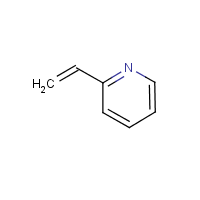2-Vinylpyridine
Agent Name
2-Vinylpyridine
CAS Number
100-69-6
Formula
C7-H7-N
Major Category
Nitrogen Compounds

Synonyms
2-Ethenylpyridine; 2VP; Pyridine, 2-ethenyl-; Pyridine, 2-vinyl-; alpha-Vinylpyridine; [ChemIDplus] UN3073
Category
Pyridines
Description
Colorless liquid with an unpleasant odor; [HSDB]
Sources/Uses
Used as an acrylic fiber comonomer, grafting reagent (ashless lubricant dispersants), and chemical intermediate; [HSDB]
Comments
A skin, eye, nose, and mucous membrane irritant; May cause skin burns and sensitization; Emergency treatment: "Pyridine"; Pyridine is an irritant that causes CNS depression after ingestion of 1/2 cup or inhalation of 6-12 ppm; It can cause liver and kidney injury; [HSDB] May cause delayed burns to skin; A severe eye and respiratory tract irritant; May cause skin sensitization; [ICSC] A corrosive substance that can cause injury to the skin, eyes, and respiratory tract; Inhalation may cause chemical pneumonitis; May be absorbed through skin; [Alfa Aesar MSDS] May cause burns; Toxic if swallowed; Harmful if inhaled; May cause allergic skin reactions; [Aldrich MSDS] Vinylpyridines, stabilized (UN3073) has warning of explosive polymerization; [ERG 2016] See "Pyridine."
Reference Link #1
Biomedical References
Exposure Assessment
Odor Threshold Low
0.3 ppm
Odor Threshold High
0.5 ppm
Lethal Concentration
LC50 (rat) = 610 mg/m3
Explosive Polymerization
Yes
Explanatory Notes
VP = 10 mm Hg at 44.5 deg C; [HSDB] Odor threshold form HSDB; The Guide in the Flash point = 42 deg C; [ICSC] Emergency Response Guidebook is for "Vinylpyridines, stabilized."
Adverse Effects
Skin Sensitizer
Yes
Toxic Pneumonitis
Yes
Neurotoxin
Other CNS neurotoxin
Hepatotoxin
Hepatoxic (a) from occupational exposure (secondary effect) or (b) in animal studies or in humans after ingestion
Dermatotoxin
Skin burns
Diseases, Processes, and Activities Linked to This Agent
Diseases
Occupational diseases associated with exposure to this agent: